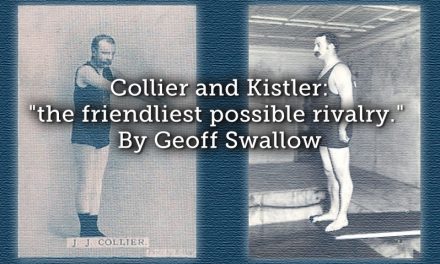Please cite this article as:
Bonini, G. Otto Herschmann: A Biographical Reassessment, In Day, D. (ed), Playing Pasts (Manchester: MMU Sport and Leisure History, 2020), 89-105.
ISBN paperback 978-1-910029-56-5
Chapter 6
______________________________________________________________
Otto Herschmann: A Biographical Reassessment
Gherardo Bonini
______________________________________________________________
Abstract
Winner of two Olympic medals in 1896 (swimming) and 1912 (fencing), and a later victim of Holocaust in 1942, Otto Herschmann must be re-evaluated as innovator of Austrian sport. A former Orthodox Jew, then assimilated as a sincere patriot, following his Olympic experience in 1896 he co-founded WAC a multi-tasking club modernizing Austrian athletics, introducing jumping, throwing and a modern training culture. Herschmann led his club to separate modern fencing from armoury, and after World War I his diplomacy brought prestige to Austria. A brilliant publicist and author of an under-rated book in 1904, from 1911 to 1914 he acted as President of Austrian sport trying to renovate national sport, he succeeded in bringing US coach Copland to manage Austrian athletics for a while. Dismissed in 1916 from the swimming federation’s Presidency, he recovered after the War and enhanced his personal prestige as fencer, albeit being over forty.
Keywords: Modernization, Patriotism, Olympic Fencing, Reform, Herschmann.
Introduction
The most reliable Austrian and international sources on Otto Herschmann limit themselves to a summary of the most important steps in his career as both athlete and trainer, underlining above all his two Olympic medals, won 16 years apart and in two separate sporting disciplines. The second medal he won when he was President of the Olympic Committee for Austria, his country of origin. Another important moment in his life was when he wrote Viennese Sport, a book which was grossly underrated when published, and considered a mere presentation of the sporting situation in Austria, although later it was interpreted as a profound sociological and cultural expression of Austria at the time. Furthermore, Herschmann was one of the unfortunate victims of the Holocaust, which finally gave him the recognition he deserved for his sacrifice.[1]
A fact which requires greater clarification, is that the more specialist sources never dated in precise temporal terms his contributions to the spheres of swimming and fencing.[2] This study, even if purely based on secondary sources and a meticulous analysis of the journalistic articles of the day, has however reconstructed a figure deserving of greater attention, an innovator in Austrian sporting tradition. Some would say he was ahead of his time in both the social and cultural sense, moreover that he was more esteemed abroad than in his home country.
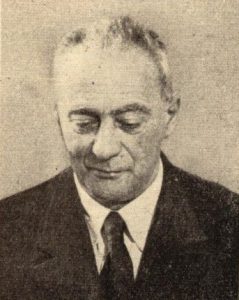
In the immediate post-War period, against the backdrop of a radically changed social-cultural environment, Herschmann finally earned, as a trainer rather than as an athlete, the recognition that had been denied to him during the war years. This analysis highlights how the common denominator in all Herschmann’s activities was the reaction towards modernity in the implementation of a project that consisted in the complete renovation of Austrian sport, having at his disposition, albeit for a brief period, the efficient tools necessary for restructuring. In future, it will be necessary to explore the dynamics of this with more appropriate archival sources.[3]
Athlete and Sporting Director for change
Born on 4 January 1877 in the Viennese district of Simmering into a wealthy Jewish family, Herschmann was enrolled as a young man in the Viennese Technical Institute, where he began to swim within the ranks of the renowned association, Erste Wiener Amateur Schwimmclub (First Vienna swimming club), better known by its acronym EWASC. The name Herschmann began to appear regularly in the sporting press from the summer of 1893. He demonstrated an impressive capacity to master new skills, learning diving techniques and the basics of water polo.[4] In 1895, the year he registered at University in the faculty of law, he also made a decisive choice by notifying the Community for Jewish Worship in Vienna of his decision to leave the Orthodox religion.[5]
In 1896, Herschmann faced a crucial turning point. At the beginning of the year, the book by Theodor Herzl, Die Judenstaat (The Jewish State) was published and was met with disgruntlement by members of the EWASC, who reacted by forbidding access to the club by Jewish swimmers. However, they did not go so far as to insert the Aryan paragraph in its statutes.[6] Even though Herschmann was not one of the best Viennese swimmers,[7] due to the state of unpreparedness of the Austrian team in relation to the new-look Olympics, he was selected to compete along with his fellow club member Paul Neumann, also a former orthodox Jew, who won the 500 metres freestyle at Athens. Herschmann came in second in the 100 metres freestyle after the Hungarian, Alfred Hajos, even if his placing was not officially recognized until 2012.[8]
At the Athens Games, the swimming competitions had none of the great British swimming champions contending such as Jack Tyers and John Henry Derbyshire, nor the star German swimmers.[9] On his return to competition in the Imperial pools, Herschmann had the same ranking he held prior to Athens, confirming that he had benefited on the Olympic stage of favourable circumstances, which had boosted his chances. His post-Olympic efforts were mainly aimed at overhauling the sporting culture of his country. He wrote reports for the famous newspaper Allgemeine Sport Zeitung (All Sports Journal) and Fremdenblatt (Foreigner Mail), which had a more liberal outlook.[10]
Herschmann was greatly impressed by the performances of US champions in athletics, a discipline that did not exist in Vienna but existed instead in Prague and Budapest. Two days after his return to Vienna, along with some fellow club members, Herschmann arrived at a town square in Prater and timed a spontaneous race of 500 metres.[11] Herschmann recorded in writing his impressions of the Olympics which had been reported on by other experts, but his analysis proved the most convincing.
Austria had the potential to renew herself because she had the resources to do so, above all human resources, to be able to compete at the same level as the most illustrious nations. However, to do this, sporting activities would have to be overhauled. This could be done by promoting athletics such as running, high and low jumps and throwing sports, introducing intensive and continuous training sessions, giving assistance to athletes, introducing sporting activities in schools, presenting physical education to the youth, and as a result change the culture and approach to sport in a decidedly conservative country.[12]
Herschmann was motivated by a sincere sense of patriotism, although he battled with the delicate question of the nationalities, which animated and perturbed the Empire. To do justice to Austria, young and fresh talent from the bourgeois classes, the self-employed and university students would be required. There would need to be a confrontation between the indolent tendencies of the middle class, inserted into the Austrian administration and formed from lesser noble families and bureaucrats, who manifested little interest in athletic pursuits, contrary to their counterparts in Prague and Budapest.
Along with other swimmers, he left EWASC and founded Wiener Athletiksport Club (WAC – Viennese club for athletic sports), the first Austrian sporting association with a multi-sport statute. In 1883, Wiener Cyclisten Club (Viennese club for Cyclists),[13] was founded and over the years the club created other sections, but only because it was encouraged to do so by its members. WAC, which was inspired along the Anglo-Saxon model, created sections for swimming, athletics, wrestling, fencing, soccer and field hockey.[14]
The sporting pages of Neues Wiener Tagblatt (Daily for Viennese News) of 22 September 1896 included a detailed article on the foundation of WAC, a sort of Club Manifesto, which gave the reader the sensation that the beginning of new era in Austrian sport was unfolding. The article was directed towards young Austrians, indicating very clearly the need for a physical and cultural regeneration. In this respect, it resounded with the position already taken by physiologists and educators in other European countries.[15] The clubs would be equipped with adequate medical facilities and the best trainers would be hired. The ‘manifesto’ was not solely Herschmann’s idea but, without a doubt, his global alignment to it was the result of his own Olympic experience and his belief that an increase in sporting quality would coincide with an increased cultural awareness of health in general. Herschmann continued to make similar appeals incorporating the same concepts and in particular he focussed his attention on the introduction of physical education in schools. Having as their target these ambitious objectives, WAC requested from its member higher ubscriptions so as to get the funding for the necessary facilities, transfers and training sessions.[16]
In 1898, thanks to its merger with Viennese Lawn Tennis Club, WAC inaugurated a tennis section, with the first women affiliates. In the same year, the club was in a strong enough position to organize major national and international competitions to mark the Jubilee of the Emperor’s reign.[17]
In the four years leading up to the second edition of the Olympics in Paris in 1900, Herschmann was no longer considered part of the elite swimming category. Instead. he was a diving instructor and dabbled in water polo. At the same time, he was sporadically involved with wrestling and athletics, in particular the most technical of the athletic disciplines, pole-vaulting. Within the organizational structure of WAC, a pair of English university coaches, Blaky and Graimley, were responsible for athletics.[18]
While he was not one of the top officials of WAC, Herschmann was heavily involved in the negotiations for the constitution of the Austrian swimming federation in 1899 and of an athletic commission in 1900[19] which meant that WAC was in a position to send three representatives in athletics to Paris.[20]
In the four-year period up to the controversial Saint Louis Olympic Games of 1904, Herschmann won his only national title in 1903 with the WAC water-polo team,[21] but first and foremost he was concentrating on achieving a certain level in fencing, under the direction of the famous instructor Master Franceschini, employed by the club since 1897.[22]
A patriotic ideal of sporting glory
In 1904, within the framework of a big editorial project designed to valorise the great city of Vienna, Herschmann wrote Wiener Sport (Viennese Sport), a book that illustrated the sporting situation in the capital and indicated how success could be achieved. What is significant is that Herschmann was chosen to write the book, as such a work had traditionally been carried out for the previous twenty years by Victor Silberer, who was the owner of the influential Allgemeine Sport Zeitung (All Sports Journal), which had been publishing since 1880 and which had dealt with the diverse sporting disciplines up until now. Silberer was President of the Rowing Federation and was involved in all developments in the sport in Austria. He enjoyed cordial relations with journalists and the privileged Viennese social classes of the period.[23]
In his book, Herschmann categorizes sports according to their social roots, aristocratic, bourgeois and working class, then by type, dedicating specific chapters to weightlifting and wrestling, swimming and canoeing, fencing, winter sports (ice-skating, tobogganing and skiing), soccer, motorsports, and finishing the book off with a review of international competitions, interpolating the analytic sections with a specific chapter on Jews in sport.
The work sought to promote the creation of a sporting community that could disseminate a new and modern mentality, a stimulating role model for a wider social renewal. Herschmann said that the state must begin to devise a policy for sports and begin to liaise with its representatives if they really wanted tangible progress. Hungary and the Bohemia were active and were represented in the International Olympic Committee (IOC), while Austria is absent.[24]
A clear methodology was required. Herschmann speaks of Austria but does not explicitly use the geo-political term of Cisleithania, effectively Austria which includes the Bohemia, and which was not limited to the single German entity of its political territory. The presence of Bohemia in the IOC led to the perception of Austria as opposed to Cisleithania.
Herschmann explained in depth his sincere ‘Cisleithanian’ patriotism, with all the national components of the state, reasserting concepts already expressed in his previous articles. He clearly stated that Austria enjoyed international credibility in weightlifting and in figure skating, but it also had the potential to emerge in other disciplines that received little state attention and no training within the school system.
He indicated some encouraging phenomena that necessitated support so they could take off at a national level; the main results were in fencing, particularly in Vienna, with the Zdarsky School in skiing, and in swimming, which would be seen in competitions where Austrian swimmers were on par with their Hungarian rivals and only slightly behind the British champions.[25]
As mentioned before, Herschmann dedicated an important chapter of his book to Jews in sport. He, himself, had decided to distance himself from his Jewish faith by assimilation, which, at the time, was a patriotic choice for him. To defend the colours of his Austrian (Cisleithanian) motherland smoothed out any internal conflicts he might have had. The Zionist position risked damaging Jewish athletes by inciting the latent anti-Semitism of the Aryans.[26]
Bourgeois fencing
In September 1904, Silberer wrote an article for Allgemeine Sport Zeitung, in which he sounded the alarm on the backwardness of Austrian sport, underlining how the presence of Jiri Guth Jarkovsky within the IOC was a bonus for Bohemian interests but not for Austria (Cisleithania).[27] Ahead of the preparations to organize an Austrian team for the Athens Olympic Games in April 1906, Hershmann and Siberer shared the same objectives. Moreover, Silberer’s son (Herbert), a renowned enthusiast for aerial sports, was involved in fencing in WAC.[28]
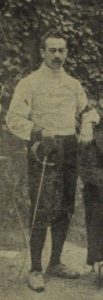
The position of Herschmann was unique, a manager but also an accomplished fencer in his own right, and by opening a fencing section, WAC was effectively bringing Viennese fencing to Olympic standard. This marked a change with the past where it was considered an almost aristocratic reserve, imbued with rituals, specialized academies and select tournaments, where the competitive result was of little real importance. Fencing in the armoury was not hostile to duels but was opposed to fencing as an Olympic sport; classificatory, athletic and competitive. The organizational chart of WAC with Count Thurn von Valassina at its head, accepted and welcomed this tradition, but within an unequivocal sporting context.[29]
Only for the purpose of finding space for the Olympic Games within the Universal Exhibition in Paris in 1900 and Saint Louis in 1904, did the Olympics host tournaments for professional Masters, as it did in the unofficial games of Athens in 1906, so fencing remained exclusively for amateurs, managed by the Olympic movement.[30] At that time, an international governing body the Union internationale d’escrime (International Union of Fencing), controlled by ‘Masters’, was founded and the Akademie der Fechtkunst (Academy of Fencing Art, hereinafter Akademie) represented Austria. The Akademie was created on the 22 September 1904 by Luigi Barbasetti, the shining light of Viennese fencing from the outset when he almost single-handedly elevated the level of the sport in Austria.[31]
The WAC fencing section was entrusted to Giovanni Franceschini, who had graduated in Rome and had been a pupil of Barbasetti. WAC opened the doors to a more democratic recruitment of fencers, anyone who wanted to attend lessons could register. Like Herschmann, WAC wanted to encourage individuals to show their athletic capabilities. Remaining true to its vocation of opening to a wider Austrian public, WAC had welcomed into its fold numerous fencers of Jewish origins, drawing some negative attention to the club in the traditionally anti-Semitist world of Viennese fencing.[32]
For these reasons, WAC and Akademie disagreed when it came to the creation of a Provisional committee for the unofficial Olympic Games of Athens 1906, which at the start only envisaged the participation of Akademie. As a first step, with Silberer’s support, Herschmann acted as representative for track and field events, and within a short time he had inspired the creation of an autonomous fencing federation, open to the academies and presided over by Adolf Richling of the imperial armed forces fencing club. Herschmann took on the role of Vice-President.[33] At this point, the Provisional Committee recognized him as a member in the position of representative of the new federation, while keeping at the same time Akademie delegates.[34]
At the Athens games, Austria sent Herschmann and other two WAC fencers, Martin Harden, who had been champion for a disbanded Austrian-German federation, and Ernst Königsgarten.[35] Even though he was eliminated, due to his poor physical condition, in the Olympic sabre tournament, Herschmann achieved a great individual result, which notably increased his international prestige. In fact he was called up to become a jury member for four categories, i.e. athletics, wrestling and gymnastics, swimming and diving, fencing and football.[36]
Unfortunately, his international success counted for little in his home country where the fencing federation did not succeed in encouraging newcomers in other associations. More certain was the traditional pool for military and aristocratic recruitment, which the rival Akademie favoured as it was equipped with a technical commission to apply correctly the rules of its competitions. The Akademie also retained the trust of the amateur sections and organized the Austrian Championships for the 13-14 May 1906. In the sabre category, Herschmann was the only civilian to reach the finals, where he competed against five soldiers and came third.[37]
Apparently, the two federations were not in conflict. The Akademie organized Austrian championships where general registration was guaranteed. The bourgeois federation, which had instituted a genuine technical commission, tried sometimes to organize championships, but was forced to give up,[38] as they feared an almost certain boycott. The public for modern events was not the same as the ritual gatherings offered in the academies offered by ‘Masters’ and military institutions. The presumption that there was a lack of appropriate education and that the civilian club did not inform their supporters on how to behave correctly, led to sharp criticism of them.[39]
Both the federations were impotent in the face of Austrian’s failure to send a complete delegation to the London Olympic in 1908. Adequate funding was not provided for the 58 prospective participants,[40] so only seven were sent to London including representatives of the WAC.[41] In 1908, the most important sporting event in Austria was the Jubilee for the sixty years of Emperor Franz Joseph’s reign. In this competition, Herschmann achieved a very satisfactory result, classified second place in the sabre tournament and fourth place in the foil tournament.[42] At the end of the year, the Olympic champion Jenö Fuchs visited Vienna seeking to meet Herschmann, who missed the Olympics for financial problems. In the bout, Fuchs was victorious, but Herschmann offered formidable resistance, confirming his status among the elite of the sport.[43]
The bourgeois federation could only organize a federal championship in the Spring of 1909, but in the same year it achieved general acclaim by organizing the University championships.[44] The students could participate in the academies, but they did not have an autonomous classification or an annual incentive. At that stage, Akademie and the federation inspired by Herschmann came to an agreement with the co-organizing of the national championships.[45]
Meanwhile, in the political field, the unresolved national conflicts and the deteriorating international situation created by the Austrian annexation of Bosnia imposed on the Austrian (Cisleithanian) State a greater cohesiveness since by this stage it was preparing for war.[46] In the sporting field, the political authorities pushed to impose a new national order, unified and cohesive, and, it understood the need for the creation of a permanent organ for the administration of national sports.[47] At the head of this new ‘Cisleithanian’ body, to which all the federations referred back to, a personality was required that was motivated by sincere patriotism and familiar with the management of a modern sports federation. The experience of WAC had shown that it could function at a national level and, after a year as vice-President under the guidance of Hans Hornacsek, Otto Herschmann took on the role of President in December 1911.[48] The disintegration of the fencing federation headed by Herschmann and its merging with the Akademie demonstrated capability, a sense of compromise and sensibility to national interests towards Cisleithania. A sub-federation functioned within the Akademie to safeguard the interests of amateur athletes.[49]
Tasks and attempts at innovation
The immediate job of Herschmann at the head of this new federal body, the Central Commission for Sports, was to prepare for the Stockholm Games, where he himself won a silver medal in the sabre team, facilitated to some extent by the French boycott of the Games. Herschmann was the fourth athlete to win two medals in different disciplines, but this time he did not take advantage of the under qualified competition of the Athens Olympics.[50] In fencing, his was an authentic rise from zero to elite athlete.
The task in the mid-term of the official Central Commission was to prepare for the Olympics of 1916, planned for Berlin, and to prepare for the ranking of Austria among the top nations. In November 1913, Herschmann dedicated himself to the most difficult assignment of his mandate, visiting the USA in search of a national athletic trainer. During his trip, he expressed sincere admiration for the training facilities, the available resources and the organization of American sport, replicating that which he had always thought and wrote about.[51] On the question of resources, the prospect of substantial economic investment would have alarmed most probably the Austrian sporting and political circles. At home, Herschmann’s trip passed almost unobserved and was focussed primarily on concrete results, i.e. recruitment of the renowned coach Bill Copland.[52]
Herschmann was not reappointed. Some of his projects, such as the construction of a new stadium in Vienna for track and field remained a dream.[53] Baron Colloredo Mansfeld, member of the IOC, succeeded Herschmann at the apex of Austrian sport. After Silberer’s complaint concerning Bohemia’s participation in the IOC in 1904, Austria succeeded in a process of marginalization of Bohemia in international sporting organizations, although there remained the original stronghold, the Bohemian presence in the IOC. Colloredo Mansfeld, who, as President of the Austrian Tennis Federation had succeeded in blocking the official entry of Bohemia in the relevant international federation, had the right profile to represent Austria at the IOC congress in Paris in June 1914, where Bohemia was officially expelled.[54]
Herschmann remained an important figure in Austrian sport and was appointed President of the Swimming Federation (VÖS), his original sport. Unfortunately, adding to his tasks as a lawyer in 1912 meant that he was not present in the major swimming events during the war. He had the misfortune in March 1916 to be given the responsibility of resolving a conflict between two clubs, Freya and EWASC, but he was not successful. As a result, he was substituted by Karl Kammerer and subsequently left the swimming federation.[55]
Post-War period: History concedes a rematch
Once the conflict was over, Herschmann was seen as an ex-athlete and ex-manager, someone who no longer counted, as he was not even a member of the steering committee of WAC anymore.[56] Since he was over 40 years of age, he decided that the only sport he could practice still was fencing and his comeback was so brilliant that he returned to the centre of attention in Austrian fencing circles. His victories while fencing for WAC between 1923 and 1924 gave him the title of best sabre man that Austria had ever produced. He brought the necessary quality to the sport in competing against the best of the Hungarian fencers who dominated in the discipline.[57]
Despite being 47 years of age, the press wanted him to compete in the Paris Olympics,[58] but Herschmann knew his own limitations and did not participate but was content with becoming once again President of the jury for the Olympic selections. The Akademie was still at this point controlling Austrian sport and the amateur sub-federation.
In November 1924, Herschmann was internationally recognized. At the Paris Games a conflict broke out between the Italians and Hungarians, the ‘Puliti case’ so a return duel was organized between Puliti and Kovacs, which took place in Nagykanizsa, Hungary.[59] The two federations were unanimous in choosing Herschmann as President of the jury. In the reports on the duel, Herschmann was praised by both sides for stopping Kovacs at the right moment and persuading him to withdraw.[60]
In 1925, Austria was readmitted into the International Fencing Federation (FIE), which had been constituted in 1913. Herschmann was considered so highly abroad that it was impossible for him not to be appointed a representative for his country. He required however, an official position and Akademie offered him the Presidency of the amateur sub-federation,[61] to reward him for his patient diplomacy, as he had never been in irremediable conflict with Akademie.
Herschmann was appointed by the FIE as official referee and he always carried out the job with competence.[62] The FIE had begun a progressive separation of the activities of ‘Masters’ and in 1928 asked Austria to follow suit. In a changed social-economic context, with a bourgeois majority and a respected aristocracy, but nostalgically tolerated, the 1906 dream of Herschmann became a reality. The Austrian bourgeois sub-federation became the recognized authority for national fencing;[63] Akademie was relegated in the organizational chart and became responsible more specifically with armoury. Herschmann was appointed first federal President in 1928, even if with a provisional mandate. News of his appointment was revealed by Richard Brünner, who like Herschmann was an excellent fencer but also active in another sport, athletics.[64]
In 1928, Herschmann, after being awarded the Order of the Crown of the Kingdom of Italy, was honoured to be appointed Head Coach for sabre team for the Amsterdam Olympics.[65]
His patient diplomacy resulted in Vienna organizing the European Championship in 1931. In Vienna, Herschmann was not the President of the Organizing Committee, but was the real force behind the event, presiding over among other things, nearly all the Championship juries.[66] In one of these, he remained firm on a controversial decision, which lead to complaints and the withdrawal of the Italian fencers. The Hungarian press, who criticized in 1928 some of his decisions at Budapest in an Italian-Hungarian match, slyly insinuated that the Italian performances were not what they seemed and that they should not have been prize winners, applauded Herschmann. [67] Maybe he was just impartial on both occasions.
In 1932 at the Los Angeles Olympic Games, Austria finally won the first fencing title in its history with foilist Ellen Preis. The leading sporting paper in Austria, Sport Tagblatt (Daily Sport Journal) asked Herschmann and not Brünner to write an article on the significant win[68] and Herschmann reiterated the sport of fencing in Austria and its history. Preis had reached her objective thanks in part to the journey that Herschamann had undertaken. At this point Herschmann decided to step down from active participation in the sport.
He dedicated himself to his professional career as a lawyer. He did not abandon Austria after the Anschluss and he was affected by the Nazi decree of the 20 November 1938 forbidding all Jewish lawyers from practicing their profession.[69] He remained in Vienna until 18 February 1942, when he was deported to Sobibor, a secondary camp to Izbica, where he died somewhere between the 14 and 17 June 1942.[70]
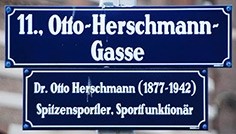
Conclusions
Although he had chosen the road of assimilation rather than Zionism, Herschmann’s roots were embedded in the Jewish culture, conserving a fundamental openness and enthusiasm towards progress and change, which clashed with the tendency to immobility and the perpetuation of the status quo by the Austrian bourgeois of the time. His choice of national identity derived from a strong element of ‘Cisleithanian’ patriotism, which was difficult to build on due to the contrasts between the nationalities. Herschmann contributed to diffusing the lessons of modernity, which he had himself learnt at the Athens Olympics, giving an inkling of a future development in Austrian sport, based on personal dedication, scientific training, and supported by the political administration with the base to be constructed in the schools. When he found the political and administrative means to act, he contributed significantly to the advancement of sport and culture in Vienna and Austria as a whole. Unfortunately, despite his diplomatic qualities and the prestige in which he was held abroad, he was ahead of his time, as he did not receive the necessary political, social and financial support for his ambitious project for a nationwide overhauling of Austrian sport.
In the Interwar period, he was officially recognized for his efforts and had some success, particularly in the field of fencing, where he brought prestige to the sport in Austria.
He represented an important figure in Austrian sport and his name should be remembered alongside those other famous and celebrated assimilated Jews such as, Hugo Meisl,[71] coach of the famous Wunderteam (Wonder Team), and Theodor Schmidt,[72] President of the Austrian Olympic Committee from 1928 to 1937. Not by chance, they shared with Herschmann a refined sense of diplomacy, the same patriotic vision and the same desire to see Austria’s prestige grow through sport and culture.
References
[1] A short profile in (editor) Joseph Siegman, Jewish Sports Legends. International Jewish Hall of Fame, (New York: International Jewish Hall of Fame, 2005), 59. For Wiener Sport in Alexander Juraske, ‚Die Jüdische Sportbewegung im Wien der Zwischenkriegszeit‘, in (editors) Bernahard Hachleitner, Matthias Marschik, Georg Spitaler, Sportfunktionäre un Jüdische Differenz. Zwischen Anerkennung und Antisemitismus. Wien 1918 bis 1938. (Berlin Germany and Boston MA : De Gruyter Oldenbourg, 2019), 71-74. On Herschmann as fencer, Michael Wenusch, Geschichte des Wiener Fechtsports im 19. Und 20. Jahrhundert, (Vienna : WUV, 1996), 88-90 and 348-352. On Herschmann as writer, Ralf Thies, Wiener Großstadt-Dokumente, Erkundungen in der Metropole der k.u.k. Monarchie, (Berlin, Forschungsschwerpunkts Technik Arbeit Umwelt am Wissenschaftszentrum Berlin für Sozialforschung, 2001), FSII =1 503, 3-47.
[2] Wrong data in ‘Österreich Sportland’ in (editor) Carl Kosik, Österreich 1918-1934, (Vienna : Heimattreue Volkschriften, 1935), 403, and in Norbert Adam, Schwimmania, (Vienna : Verband Österreichische Schwimmvereine, 1999), 10.
[3] Archives of Austrian Olympic Committee are lacunose according Erwin Niedermann, Olympische Bewegung in Österreich, (Vienna: Edwin Bauer & Co, 1995), 93.
[4] Allgemeine Sport Zeitung, July 23, 1893, 775, also August 12, 1894, 912.
[5] Anna Staudacher, ‘….meldet den Austritt aus dem mosaischen Glauben’. 18.000 Austritte aus dem Judentum in Wien 1868-1914. Namen, Quellen, Daten, (Zürich : Peter Lang, 2009), 245.
[6] Bernhard Hachleitener, ‘Arierparagraphen und anderen Ausschussmechanismen‘ in (editors) Hachleitner, Marschik, Spitaler, Sportfunktionäre, 35.
[7] In the unofficial European championships of Vienna in 1895 in the mile, Herschmann placed 5th only, Sportvilàg (Budapest), August 11, 1895, 6.
[8] In his writing in Allgemeine Sport Zeitung, April 26, 1896, 402, Herschmann confirmed his 2nd place. On 24 July 2012, Austrian journal Kurier reports the officialization in https://kurier.at/sport/nach-116-jahren-silber-fuer-otto-herschmann/805.357 (accessed October 20, 2018).
[9] Tyers dominated English and international swimming from middle to long distances. Derbyshire was the best specialist of 100 yards.
[10] Neues Wiener Tagblatt, May 30, 1896, 30 and Allgemeine Sport Zeitung, July 26, 1896, 829.
[11] Sport Tagblatt mentioned the anecdote on September 11, 1936.
[12] ‘Die Österreicher in Olympia’ (The Austrian at Olympics), Allgemeine Sport Zeitung, April 26, 1896, 402. His collaborations with Fremdenblatt started in 1896, according Thies, Wiener Großstadt-Dokumente, 31.
[13] Merging with Wiener Sportvereinigung (Viennese Association for Sport) the Wiener Cyclisten Club in 1907 set up another multi-tasking club, the Wiener Sportklub.
[14] WAC, 1896-1946. Wiener Athletiksport Club, (Vienna : 1946), 2.
[15] For Italy, Angelo Mosso put the model of English sports, as mentioned by Susanna Spezia, ‘Emilio Baumann, Angelo Mosso e una famosa polemica’, in (editors) Adolfo Noto, Lauro Rossi, Coroginnica. Saggi sulla ginnastica, lo sport e la cultura del corpo, (Roma : La Meridiana, 1992), 110. In Germany and in France, the renewal assumed a profile of hygienic, aesthetic and muscular regeneration, as mentioned by Alan Radley, The Illustrated History of Physical Culture. Volume 1. The Muscular Ideal, (London, Snapes & Preston, 2001), 46 and ssgg.
[16] Wenusch, Geschichte des Wiener Fechtsports, 89.
[17] The most important event took place on 31 July and 1 August with the European Championship for Greco-Roman wrestling coupled with the World championship of weightlifting. Regarding athletics, WAC organized the Austrian championship of 1000 metres and Viennese championships for 100 yards.
[18] In the pole vault, Herschmann exceeded 2,65, see Neues Wiener Tagblatt, October 2, 1899. The mention of the two English athletes and trainers in Neues Wiener Tagblatt, December 3, 1896.
[19] Allgemeine Sport Zeitung, February 19, 1899, 187 and June 7, 1900, 1114.
[20] They were Hermann Wraschtil, Carl Lubowiecki e Siegfried Flesch, see Bill Mallon, The 1900 Olympic Games, Results for All Competitors in All Events, with Commentary, (Jefferson, North Carolina: McFarland & Company, 1998), 259-260
[21] WAC, 25 Jahre., Vienna, 1921, 12.
[22] About Franceschini, Wenusch, Geschichte der Wiener Fechtsports, 88.
[23] About Victor Silberer, see Rudolf Müllner, ‘Sport and Media.Austria before 1900’ in (editors) Arnd Krüger and Wolfgang Büss, Transformationen, Kontinuitäten und Veränderung in der Sportgeschichte, (Hoya : 1988), Volume I, 87-90.
[24] Otto Herschmann, Wiener Sport, (Vienna : 1904), 8-10.
[25] Herschmann, Wiener Sport, 75.
[26] Herschmann, Wiener Sport, 25-27. Good comments in Alexander Juraske, Die Jüdische Sportbewegung im Wien, 71-73.
[27] Allgemeine Sport Zeitung, October 2, 1904, 1203. Cisleithania was geo-political name for Austria and entered into force after the Ausgleich (Compromise) of 1867 that gave birth to the Austro-Hungarian Empire. Cisleithania comprised Bohemia. Stephan Vajda, Storia dell’Austria. Mille anni fra Est e Ovest, (Milano : Bompiani, 1980), 419.
[28] The best article by Herbert Silberer Die Erste Fahrt der Aero-Klub (The first Journey of Aero Club) in Allgemeine Sport Zeitung, August 18, 1901, 947. He placed fifth in foil in the Jubilee Tournament 1908.
[29] About the emancipation of the fencing sport from armoury, good comments in Cécile Ottogalli, Gérard Six, Thierry Terret, Histoire de l’escrime. 1913-2013. Un siècle de la fédération internationale d’escrime, (Paris : Atlantica, 2013), 9-18.
[30] Bill Mallon, Ian Buchanan, The 1908 Olympic Games, Results for All Competitors in All Events, with Commentary, (Jefferson, North Carolina : McFarland & Company, 2000), 137-47.
[31] About Luigi Barbasetti and the Akademie der Fechtkunst (Academy of Fencing Art), again Wenusch, Geschichte der Wiener Fechtsports, 80.
[32] Wenusch, Geschichte der Wiener Fechtsports, 353.
[33] Allgemeine Sport Zeitung, March 4, 1906, 216.
[34] Allgemeine Sport Zeitung, February 18, 1906, 167.
[35] Bill Mallon, The 1906 Olympic Games, Results for All Competitors in All Events, with Commentary, (Jefferson, North Carolina : McFarland & Company, 1999), 175-177. The Austrian-German Federation was founded in 1897, but collapsed in 1901, see Deutsche Fechter Bund, 50 Jahre Deutsche Fechter Bund, Berlin 1961, 11.
[36] Mallon, The 1906 Olympic Games, 37, 76, 79, 83, 99, 106, 127, 149.
[37] Allgemeine Sport Zeitung, May 20, 582.
[38] A stiff polemic rose against Viennese championship 1905 that announced by WAC, see Allgemeine Sport Zeitung, March 12, 1905.
[39] Allgemeine Sport Zeitung, April 5, 1908, 355.
[40] Allgemeine Sport Zeitung, March 1, 1908, 203-204.
[41] Mallon, Buchanan, The 1908 Olympic Games, 419.
[42] Allgemeine Sport Zeitung, June 28, 1908, 800-801.
[43] Allgemeine Sport Zeitung, October 31, 1908, 1371.
[44] Allgemeine Sport Zeitung, March 28, 1909, 342 and May 16, 1909, 588.
[45] Allgemeine Sport Zeitung, April 3, 1910, 353.
[46] Alexander May, The Hapsburg Monarchy. 1867-1914, (New York: Norton, 1968), 426-428.
[47] Allgemeine Sport Zeitung, December 18, 1910, 1677.
[48] Allgemeine Sport Zeitung, December 17, 1911, 1713.
[49] Herschmann assumed ad hoc the Presidency and superseded the negotiations, Neues Wiener Tagblatt, May 6, 1911.
[50] Three athletes, i.e. the German Schumann (gymnastics/wrestling), Hofmann (athletics/gymnastics) and Australian Flack (athletics/lawn tennis) did double achievement in 1896.
[51] For instance, Marion Star, November 18, 1913.
[52] Allgemeine Sport Zeitung, November 30, 1913, 1655.
[53] Neues Wiener Sportblatt, January 10, 1920, 2. The journal New York Tribune, December 3, 1913 estimated an expenditure of 800,000 US dollars.
[54] Allgemeine Sport Zeitung, February 22, 1914, 35. On the Bohemian expulsion from IOC, Gherardo Bonini, ‘The Bohemian question in the international sporting organizations (1892-1914)’, in (editors) Semmelweiss University Budapest, 6th Congress of ISHPES. Budapest, 14-19 July 1999. Proceedings, (Budapest : Semmelweiss University, 2002), 340-341.
[55] Neues Wiener Tagblatt, May 20, 1916.
[56] Neues Wiener Sportblatt, January 20, 1920, III.
[57] The Italian journal Gazzetta dello Sport, March 19, 1924, 3 greeted the new spring of Austrian fencing.
[58] Sport Tagblatt, May 6, 1924.
[59] Thierry Terret, Jean Saint-Martin, Cecile Ottogalli-Mazzacavallo, ‘The Puliti affair and the 1924 Paris Olympics : Geo-political issues, National pride and Fencing traditions’, in The International Journal of the History of Sport, 25 (2007)10, 1381-1401. No mention for Herschmann’s role.
[60] Sport Hirlap, November 13, 1924.
[61] Sport Tagblatt, February 17, 1925.
[62] Escrime et tir, 3(1926), 23.
[63] Sport Tagblatt, July 28, 1928.
[64] Before World War I, Brünner won Viennese title for 100 metres in 1908. He won the Austrian foil title in 1920, 1924 and 1927, and in sabre in 1922, 1925
[65] Sport Tagblatt, July 20, 1928.
[66] Herschmann drove the press release, Sport Tagblatt, May 30, 1931. Nemzeti Sport, May 31, 1931 praised him for conduction of Jury.
[67] Nemzeti Sport, May 31, 1931.
[68] Sport Tagblatt, August 6, 1928.
[69] Barbara Sauer, Ilse Reiter-Zatloukal, Advokaten 1938. Das Schicksal der in den Jahren 1938 bis 1945 verfolgten österreichischen ReichtsanwältInnen und Rechtsanwälte, (Vienna : Manz, 2010), 178.
[70] Siegman, Jewish Sports Legends, 159.
[71] About Meisl, Andreas Hafer, Wolfgang Hafer, Hugo Meisl oder der Erfindung des modernen Fussballs. Eine Biographie. (Göttingen : Verlag die Werkstatt, 2007)
[72] Matthias Marschik, Theodor Schmidt. Eine Jüdische Apostel der Olympische Idee’, (Berlin : Heinrich & Heinrich, 2018)

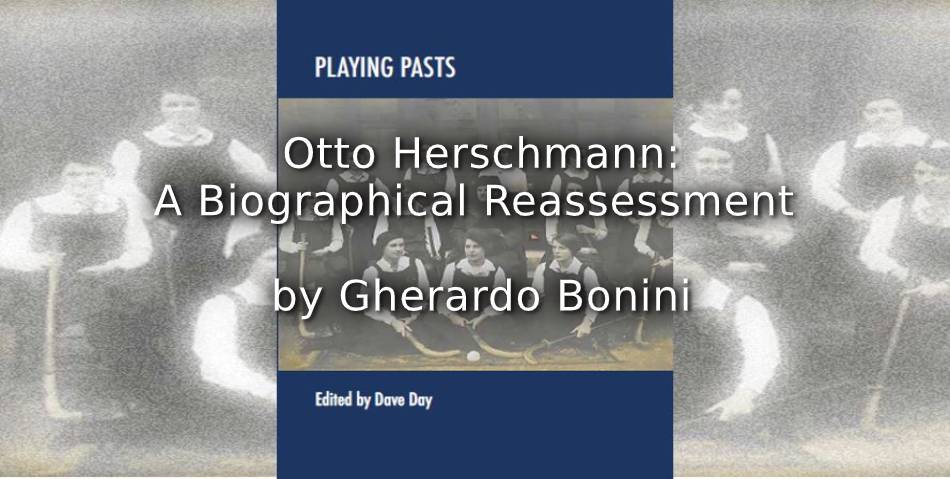
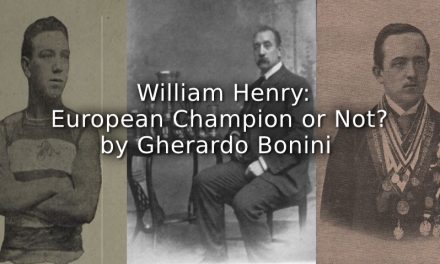
![Switching from Women’s Football to Cross-Country: <br>The History of Gruppo Sportivo Giovinezza [Milan, 1933-37]](https://www.playingpasts.co.uk/wp-content/uploads/2020/07/PP-banner-maker-440x264.jpg)

